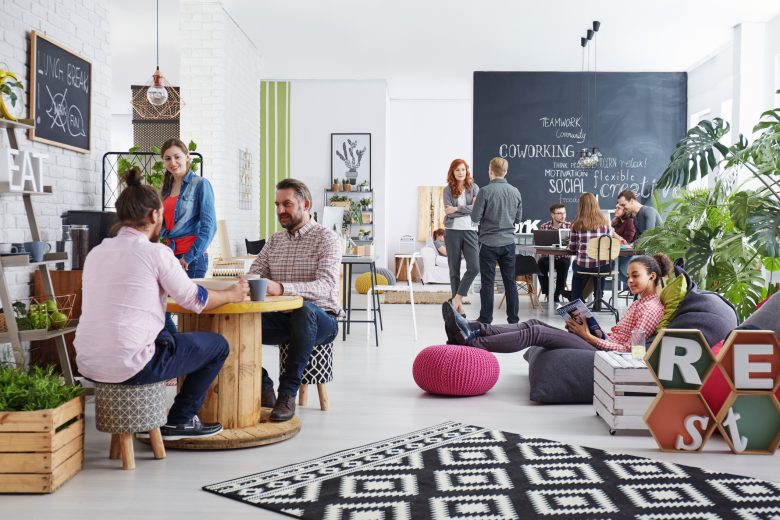How we work is often a reflection of the space where we work—but what type of office design is the best for productivity and morale?
In the early 1900s, the importance of the thought behind office design became apparent. Engineer Frederick Taylor has been credited as one of the first people to design an office space. With a focus on efficiency, he laid out an open-concept workspace for employees to work while their superiors kept watch from their private offices.
Many believed this type of layout discouraged productivity and in the 1960s the cubicle was introduced to provide privacy. Unfortunately, the efficient design of the cubicle was over-utilized in the 1980s in order to put as many people into a workspace as possible. In the wake of the recession, companies took advantage of this type of office layout to achieve cost savings. A sea of cubicles became the norm and with the threat of downsizing, company bankruptcies and general uncertainty it’s no wonder why the bland design left employees disengaged and unhappy.
The new millennium brought a fresh outlook and change to the office dynamic: virtual offices. Technology advancements have also advanced the way work is conducted. While virtual offices worked for some, others found they needed to have a space they could call their own at work to continue being productive.
Aspects of these designs throughout history have inspired some of the most effective offices today. Some people believe an open concept can encourage collaboration while others feel that it’s anti-productive and causes too much distraction. But there’s more to a well-designed office than where people sit. Since stress can be a detriment to productivity, a lot of workplaces are incorporating things to boost happiness in the workplace. A positive work environment has been proven to increase productivity and engagement while decreasing absenteeism and downtime.
Must-haves on the office design wishlist to increase productivity:
- More natural light. Natural light is important for positive mental and physical health and not getting enough light can negatively influence performance and wellbeing, and can contribute to chronic illnesses and fatigue. Research has shown that productivity is increased significantly when employees are exposed to natural light during their workday.
- Provide the tools to succeed. It can be frustrating to try to complete the functions of your job when you’re not given the right tools—which includes the right functional space. Task-specific workstations or designated meeting rooms are a practical and environmentally friendly design to increase productivity within an office space. It’s also important to look at the setup of the office equipment—it should be servicing employees’ job functions, and their job functions shouldn’t be impeded by the inconsiderate placement of equipment.
- Think about their health. Offering wellness options to workers will not only show them that their employer cares but will be better for their overall health, which will increase productivity, decrease downtime and create a better workplace for all. Wellness options can include offering a gym in your facility or an outside gym membership to employees, meditation or nap rooms, healthy snacks, and a flexible schedule. An often overlooked factor is providing access to greenery. According to University of Washington Urban Forestry/Urban Greening Research, both visual access and being within green space helps to restore the mind’s ability to focus.
- Allow some fun. Whether it’s putting a gaming table (foosball, ping pong, air hockey, billiards) in the break room, team building through outside activities like golf or paintball or even just taking a break and enjoying a pizza lunch—these gestures are great stress relievers that build trust and let employees know they are appreciated. When employees feel appreciated, it inspires them to want to do more.
Recently, SafeStart General Manager Barb Tait was interviewed for Building Profit magazine about her 2017 Butler Design Award-winning new office space. In the article, she indicated that every item on her wish list was checked off. She said:
Many companies want to build showcase offices with dramatic meeting rooms that feature the latest technologies. What was important to us? A great, new warehouse. Butler seems to create buildings from the inside out, considering people and their states of mind. This mindset completely aligns with what we try to do with our clients.
SafeStart’s wish list included an open, bright, modern and collaborative space that was energy efficient. Butler and the builder, Bel-Con Design-Builders, checked off all of the required must-haves and then some.
More natural light
- Butler’s SunLite Strip daylighting system as well as skylights and curtain walls. It’s hard to find a dark corner in the building.
Provide the tools to succeed
- Specialized meeting and webinar rooms with advanced technology, which are used for remote teaching opportunities and video conferencing.
- An expanded warehouse and assembly area.
Think about their health
- Bel-Con kept the connection to the outdoors with woods, foliage and wildlife nearby. They also built a patio, encouraging workers to take breaks outside.
- A small room is available for meditation, a quiet place to think or just a solitary break.
Allow some fun
- A large break room with ping pong and foosball tables.
- Bistro tables line the hallway to encourage people to stop and have a conversation while not disrupting people that are working.
Read the full article on SafeStart’s new building, which is available here.

